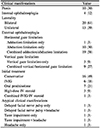Abstract
Purpose
To investigate the clinical features of acute ophthalmoplegia associated with anti-GQ1b antibody in the Republic of Korea.
Methods
From January 2011 to July 2018, we retrospectively reviewed the medical records of all patients who tested positive for anti-GQ1b antibody, and who had been concurrently diagnosed with acute ophthalmoplegia at a tertiary hospital in the Republic of Korea. Ophthalmic and neurological features were carefully reviewed. Laboratory results including ganglioside antibody panels and treatment outcomes were analyzed.
Results
Thirty-three patients were enrolled in the study and 8 (24%) of them showed pure Miller-Fisher syndrome with all three cardinal symptoms of ophthalmoplegia, ataxia, and areflexia. One patient (3%) showed ophthalmoplegia, areflexia, and pharyngeal- cervical-brachial weakness without ataxia and 2 patients (6%) showed only ophthalmoplegia and pharyngeal-cervical- brachial weakness without ataxia and areflexia. Twenty-two patients (67%) showed only ophthalmoplegia without any other neurological symptom. Early immunosuppressant treatment was used to treat 17 patients, and observation only was conducted as the initial treatment for 16 patients (48.5%). Twenty-four patients (72.7%) showed improvement and 9 patients showed persistent strabismus and diplopia. The average duration until recovery was 2.52 ± 2.11 months.
Figures and Tables
References
1. Fisher M. An unusual variant of acute idiopathic polyneuritis (syndrome of ophthalmoplegia, ataxia and areflexia). N Engl J Med. 1956; 255:57–65.
2. Sekiguchi Y, Mori M, Misawa S, et al. How often and when Fisher syndrome is overlapped by Guillain-Barré syndrome or Bickerstaff brainstem encephalitis. Eur J Neurol. 2016; 23:1058–1063.
3. Nishimoto Y, Odaka M, Hirata K, Yuki N. Usefulness of anti-GQ1b IgG antibody testing in Fisher syndrome compared with cerebrospinal fluid examination. J Neuroimmunol. 2004; 148:200–205.
4. Odaka M, Yuki N, Hirata K. Anti-GQ1b IgG antibody syndrome: clinical and immunological range. J Neurol Neurosurg Psychiatry. 2001; 70:50–55.
5. Friedman DI, Potts E. Headache associated with miller fisher syndrome. Headache. 2007; 47:1347–1348.
6. Kim JK, Kim BJ, Shin HY, et al. Does delayed facial involvement implicate a pattern of “descending reversible paralysis” in Fisher syndrome? Clin Neurol Neurosurg. 2015; 135:1–5.
7. Mori M, Kuwabara S, Fukutake T, et al. Clinical features and prognosis of Miller Fisher syndrome. Neurology. 2001; 56:1104–1106.
8. Ohe Y, Shintani D, Kato Y, Tanahashi N. Fisher syndrome with taste impairment. Intern Med. 2012; 51:2977–2979.
9. Tan CY, Yuki N, Shahrizaila N. Delayed facial palsy in Miller Fisher syndrome. J Neurol Sci. 2015; 358:409–412.
10. Yagi Y, Yokote H, Watanabe Y, et al. Taste impairment in Miller Fisher syndrome. Neurol Sci. 2015; 36:809–810.
11. Koga M, Yuki N, Hirata K. Pain in Miller Fisher syndrome. J Neurol. 2000; 247:720–721.
12. Yuki N, Odaka M, Hirata K. Acute ophthalmoparesis (without ataxia) associated with anti-GQ1b IgG antibody: clinical features. Ophthalmology. 2001; 108:196–200.
13. Ropper AH. Further regional variants of acute immune polyneuropathy. Bifacial weakness or sixth nerve paresis with paresthesias, lumbar polyradiculopathy, and ataxia with pharyngeal-cervical-brachial weakness. Arch Neurol. 1994; 51:671–675.
14. Van der Meché FG, Van Doorn PA, Meulstee J, et al. Diagnostic and classification criteria for the Guillain-Barré syndrome. Eur Neurol. 2001; 45:133–139.
15. Uncini A, Susuki K, Yuki N. Nodo-paranodopathy: beyond the demyelinating and axonal classification in anti-ganglioside antibody-mediated neuropathies. Clin Neurophysiol. 2013; 124:1928–1934.
16. Koga M, Gilbert M, Takahashi M, et al. GQ1b-seronegative Fisher syndrome: clinical features and new serological markers. J Neurol. 2012; 259:1366–1374.
17. Koga M, Gilbert M, Li J, et al. Antecedent infections in Fisher syndrome: a common pathogenesis of molecular mimicry. Neurology. 2005; 64:1605–1611.
18. Jacobs BC, Rothbarth PH, van der Meché FG, et al. The spectrum of antecedent infections in Guillain-Barré syndrome: a case-control study. Neurology. 1998; 51:1110–1115.
19. Ropper AH. Unusual clinical variants and signs in Guillain-Barré syndrome. Arch Neurol. 1986; 43:1150–1152.
20. Willison HJ, O'Hanlon G, Paterson G, et al. Mechanisms of action of anti-GM1 and anti-GQ1b ganglioside antibodies in Guillain-Barré syndrome. J Infect Dis. 1997; 176 Suppl 2:S144–S149.
21. Chapman J, Sela BA, Wertman E, Michaelson DM. Antibodies to ganglioside GM1 in patients with Alzheimer's disease. Neurosci Lett. 1988; 86:235–240.
22. Chiba A, Kusunoki S, Obata H, et al. Serum anti-GQ1b IgG antibody is associated with ophthalmoplegia in Miller Fisher syndrome and Guillain-Barré syndrome: clinical and immunohistochemical studies. Neurology. 1993; 43:1911–1917.
23. Yuki N, Hartung HP. Guillain-Barré syndrome. N Engl J Med. 2012; 366:2294–2304.
24. Umapathi T, Tan EY, Kokubun N, et al. Non-demyelinating, reversible conduction failure in Fisher syndrome and related disorders. J Neurol Neurosurg Psychiatry. 2012; 83:941–948.
25. Jung JH, Oh EH, Shin JH, et al. Atypical clinical manifestations of Miller Fisher syndrome. Neurol Sci. 2019; 40:67–73.
26. Nishijima H, Tomiyama M, Suzuki C, et al. Taste impairment in Guillain-Barré syndrome: more frequent than thought? J Peripher Nerv Syst. 2011; 16:270–271.
27. Jung JW, Lee JH, Jung JH. The characteristics and prognosis of Miller Fisher syndrome. J Korean Ophthalmol Soc. 2017; 58:197–202.




 PDF
PDF ePub
ePub Citation
Citation Print
Print



 XML Download
XML Download